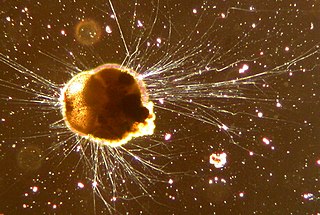
Foraminifera are single-celled organisms, members of a phylum or class of amoeboid protists characterized by streaming granular ectoplasm for catching food and other uses; and commonly an external shell of diverse forms and materials. Tests of chitin are believed to be the most primitive type. Most foraminifera are marine, the majority of which live on or within the seafloor sediment, while a smaller number float in the water column at various depths. Fewer are known from freshwater or brackish conditions, and some very few (nonaquatic) soil species have been identified through molecular analysis of small subunit ribosomal DNA.

The Globigerinina is a suborder of foraminiferans that are found as marine plankton. They produce hyaline calcareous tests, and are known as fossils from the Jurassic period onwards. The group has included more than 100 genera and over 400 species, of which about 30 species are extant. One of the most important genera is Globigerina; vast areas of the ocean floor are covered with Globigerina ooze, dominated by the shells of planktonic forms.
Stetsonia is the scientific name of two genera of organisms and may refer to:

The Fusulinida is an extinct order within the Foraminifera in which the tests are composed of secreted hyaline calcite. Like all forams, they were single-celled organisms. In advanced forms the test wall was differentiated into two or more layers. Loeblich and Tappan, 1988, gives a range from the Lower Silurian to the Upper Permian, with the fusulinid foraminifera going extinct with the Permian–Triassic extinction event. While the latter is true, a more supported projected timespan is from the Mid-Carboniferous period.
The Robertinida are an order of Middle Triassic to recent, benthic foraminifera in which tests are planispirally to trochospirally coiled, with chambers provided with an internal partition and hyaline perforated walls composed of optically radiated aragonite.
Miliamellus is a genus of Cenozoic benthic foraminifera with tests made of imperforate opaline silica. It is the only genus in the order Silicoloculinida and the family Silicoloculinidae. It is sometimes referred to by the junior synonym Silicoloculina.

Cibicides is a genus of cosmopolitan benthic foraminifera known from at least as far back as the Paleocene that extends down to the present.
Discorbis is a genus of benthic Foraminfera, that made its first appearance during the Eocene. Its present distribution is cosmopolitan.
Rosalina is a genus of foraminifera included in the rotaliid family Rosalinidae.
The Cassidulinacea is a superfamily of benthic amoeboid foraminifera in the order Rotaliida that has been extant from the Paleocene down to the present. Tests are composed of secreted, optically radial or granular, perforate calcite with chambers biserially coiled at least in the early part, Apertures are usually an interiomarginal slit, but may become terminal and may have secondary features.
Hedbergella is an extinct genus of planktonic foraminifera from the Cretaceous, described by Loeblich and Tappan, 1961, as:
Test free, trochospiral, biconvex, umbilicate, periphery rounded with no indication of keel or poreless margin; chambers globular to ovate; sutures depressed, radial, straight or curved; wall calcareous, finely perforate, radial in structure, surface smooth to hispid or rugose; aperture an interiomarginal, extraumbilical-umbilical arch commonly bordered above by a narrow lip or spatulate flap, ... Includes species otherwise similar to Praeglobotruncana but which lack a keel or poreless margin, hence is regarded as a separate genus rather than as a subgenus of Praeglobotruncana as by Banner and Blow (1959).
The Globoroatioidea constitutes a superfamily of Cenozoic plantonic foraminifera. It is part of the suborder Globigerinina. Globoroatioidea have trochospiral tests with rounded to carinate peripheries, the walls of which are of finely lamellar, perforate, of optically radial calcite, with an inner organic lining. The surface of these tests is smooth, lacking spines, but may be covered with pustules or pitted, and may have one or more large pores at the center. There is a single primary aperture that may be bordered by an imperforate lip, as well as possible supplementary apertures.
Helen Niña Tappan Loeblich was an American micropaleontologist who was a professor of geology at the University of California, Los Angeles, a United States Geological Survey (USGS) biostratigrapher, and a scientific illustrator whose micropaleontology specialty was research on Cretaceous foraminifera.

Globothalamea comprises a class of multichambered foraminifera based in part on SSU rDNA evidence; the other is Tubothalamea.
Spirocyclinidae is a family of foraminifera included in the order Loftusiida.

Peneroplis is a genus of Foraminifera in the family Peneroplidae. The genus is also represented in the fossil record.

Cyclammina is a genus of foraminifers in the family Cyclamminidae. Most species are extinct, but there are a few that are extant.

Cuneolina is an extinct genus of prehistoric foraminifera in the family Cuneolinidae with species from the Jurassic and Cretaceous.
Earlandia is a genus of prehistoric foraminifera.
Acarinina is an extinct genus of foraminifera belonging to the family Truncorotaloididae of the superfamily Globorotalioidea and the suborder Globigerinina. Its fossil range is from the upper Paleocene to the middle Eocene. Its type species is Acarinina nitida.







